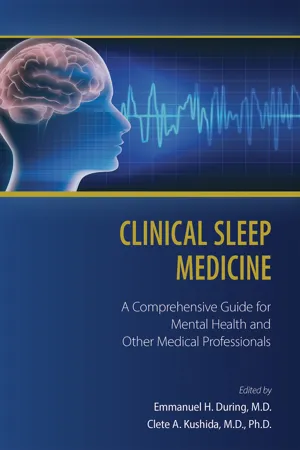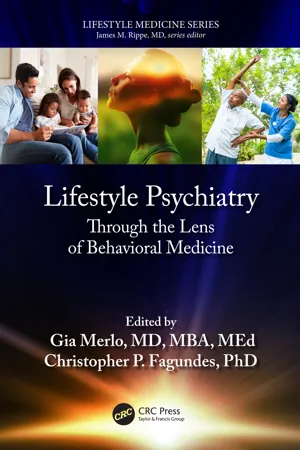Psychology
Improving Sleep
Improving sleep involves adopting healthy sleep habits and addressing any underlying sleep disorders. Strategies may include maintaining a consistent sleep schedule, creating a relaxing bedtime routine, and ensuring a comfortable sleep environment. Additionally, managing stress, limiting caffeine and electronic device use before bed, and seeking professional help if experiencing persistent sleep difficulties can also contribute to better sleep quality.
Written by Perlego with AI-assistance
Related key terms
Related key terms
1 of 4
Related key terms
1 of 3
5 Key excerpts on "Improving Sleep"
- eBook - ePub
Sport and Exercise Psychology
Practitioner Case Studies
- Stewart Cotterill, Neil Weston, Gavin Breslin, Stewart Cotterill, Neil Weston, Gavin Breslin(Authors)
- 2016(Publication Date)
- Wiley-Blackwell(Publisher)
Cognitive therapy – aims at challenging and changing misconceptions about sleep and faulty beliefs about a lack of sleep. Also can seek to reduce excessive monitoring of, and worrying about, insomnia and its consequences.Sleep hygiene education – linked to health practices (e.g., diet, exercise, substance use) and environmental factors (e.g., light, noise, and temperature) that can promote or interfere with sleep.Cognitive-behaviour therapy – a combination of any of the above behavioural (e.g., stimulus control, sleep restriction, relaxation) and cognitive procedures.A combination of some of the approaches outlined was adopted in the current case study, with the interventions specifically focusing on sleep hygiene in the short term and adopting a cognitive-therapy approach in the longer term to challenge the rumination and tendency to over-think and worry. The sleep hygiene part of the intervention built upon the recommendations of Hauri (1991) to successfully impact upon pre-sleep behaviour. Hauri (1991) suggested the following six steps to enhancing sleep hygiene:- Curtail time in bed – only be in bed for the time you are sleeping.
- Never try to sleep – engage in activities such as reading, watching television, or listening to radio discussions for as long as possible.
- Eliminate the bedroom clock – time pressure is not conducive to sleep.
- Exercise in late afternoon/early evening – linked to producing a core body temperature drop (conducive for sleep) 4–6 hours later.
- Avoid caffeine, alcohol, and nicotine prior to bed.
- Regularize bedtime.
Similar sleep hygiene techniques have been adopted in sport by Hung, Tang, and Shiang (2009) in their work with an Olympic archer in an attempt to reduce the potential impacts of insomnia on performance.Building upon the existing literature evidence, and mindful of the specific constraints that existed, the following five steps were adopted:- To never try to sleep, specifically look to read.
- To only use the bed for sleep. Owing to the travel required as part of competitive cricket and the significant number of evenings spent in hotels, it was not realistic to only use the bedroom for sleeping. But this could be adapted to only use the bed for sleep and to use the chairs provided for other activities such as watching television.
- eBook - ePub
Clinical Sleep Medicine
A Comprehensive Guide for Mental Health and Other Medical Professionals
- Emmanuel H. During, Clete A. Kushida(Authors)
- 2020(Publication Date)
- American Psychiatric Association Publishing(Publisher)
Hauri 1991 ). Environmental factors include establishing a protected sleep environment. Lifestyle practices include appropriate timing and consumption of meals, exercise, alcohol, and caffeine. For example, individuals are encouraged to keep their bedroom comfortable, dark, quiet, and cool (62°F–68°F), although preferences can vary. Recommendations for keeping screens and electronic devices out of the bedroom are becoming increasingly common. Meals, exercise, alcohol, and caffeine should all be timed appropriately so they do not interfere with sleep (i.e., meals, alcohol, and vigorous exercise should be finished 3–4 hours before bedtime; caffeine should be finished 10–14 hours before bedtime). Caffeine and alcohol should be limited or eliminated in individuals who are sensitive to their effects. Nicotine should be discontinued because of adverse effects on sleep and health. Proper sleep hygiene can support good sleep but does not, by itself, correct poor sleep.Cognitive-Behavioral Therapy for Insomnia
Description and Indication
CBT-I is a brief, collaborative, skills-based, multicomponent treatment that uses a variety of therapies, some of which are effective as stand-alone interventions, to target thoughts and behaviors that interfere with sleep and perpetuate insomnia. Specific therapies include stimulus control, sleep restriction, relaxation, cognitive reframing, sleep hygiene, and sleep education. Changing unhelpful beliefs and behaviors can circumvent the vicious circle that ensues when unhelpful cognitions, negative emotions, and maladaptive behaviors exacerbate and perpetuate insomnia, an understanding that informs CBT treatment for other chronic conditions (Hofmann et al. 2012 ). CBT-I can be safely implemented with young, middle-aged, and older adults with chronic insomnia. See Table 5–1 - eBook - ePub
Lifestyle Psychiatry
Through the Lens of Behavioral Medicine
- Gia Merlo, Christopher P. Fagundes, Gia Merlo, Christopher P. P. Fagundes(Authors)
- 2023(Publication Date)
- CRC Press(Publisher)
Section III Risk and Protective Lifestyle Factors for Mental Health and Psychological Well-BeingPassage contains an image
17 Sleep-Related Disorders
Matthew R. Cribbet, PhD, Andrea N. Decker, MA, Francisco D. Marquez, ScM, MA, and Emily A. Halvorson, MADOI: 10.1201/b22810-20KEY POINTS
- Insomnia disorder is associated with short-term and long-term deficits in functioning, including co-morbid medical and psychiatric complaints.
- Cognitive Behavioral Therapy for Insomnia is an evidence-based treatment with demonstrated efficacy and effectiveness.
- Scaling up insomnia treatments will address growing demands for patient care.
17.1 Introduction
Insomnia disorder is characterized by difficulties falling asleep, staying asleep, or non-restorative sleep that occurs despite the opportunity for adequate sleep. Insomnia disorder is associated with significant distress or impairment in functioning, along with daytime symptoms, including mood disturbances, fatigue, daytime sleepiness, and impairments in cognitive functioning.1 While nearly one-third to one-fourth of individuals in industrialized countries report disrupted sleep at some point during their lives, approximately 10% to 25% of the population meets the diagnostic threshold for insomnia disorder.2 Insomnia is a chronic problem in one-third to three-fourths of patients,3 , 4 with more than two-thirds of patients reporting symptoms for at least 1 year.5 Without intervention, chronic insomnia is unremitting, disabling, costly, and may pose a risk for additional morbidity and potentially mortality.6 , 7 Given the scope and significance of this problem the identification and implementation of efficacious and effective forms of treatment is necessary. Cognitive behavioral therapy for insomnia (CBT-I) is not only efficacious and effective, it is now considered the standard of treatment for chronic insomnia8 and is recommended as the initial treatment by the American College of Physicians.9 - eBook - ePub
- Michael A. Grandner(Author)
- 2019(Publication Date)
- Academic Press(Publisher)
Fig. 27.2 ). Environmental factors, changes to cognitive function and emotional changes are all altered by sleep loss and can influence desire and self-control, motivation and energy to engage in health behaviors. Although a great deal of research has focused on how sleep loss affects these basic cognitive processes, only a few studies have evaluated how these changes affect health behavior and decision making. In addition, translational research is needed to understand how sleep effects behavioral decision making in naturalistic settings. Finally, given that vulnerabilities exist, interventions are needed to (1) determine if Improving Sleep can help other health behaviors, and (2) when changing sleep is not possible, if addressing the underlying vulnerability in those at risk for sleep loss (e.g., cognitive interventions).Fig. 27.2 Conceptual diagram demonstrating the complex interaction of environment, neurocognitive function, and emotional changes associated with sleep loss and circadian disruption.References
[1] Kvaavik E., Batty G.D., Ursin G., Huxley R., Gale C.R. Influence of individual and combined health behaviors on total and cause-specific mortality in men and women: the United Kingdom health and lifestyle survey . Arch Intern Med . 2010;170(8):711–718.[2] Gochman D.S. Handbook of health behavior research . New York, NY: Plenum; 3. 1997;vol. 1–4.[3] Borbély A.A. A two process model of sleep regulation . Hum Neurobiol . 1982;1(3):195–204.[4] Lutter M., Nestler E.J. Homeostatic and hedonic signals interact in the regulation of food intake . J Nutr . 2009;139(3):629–632.[5] Lowe M.R., Butryn M.L. Hedonic hunger: a new dimension of appetite? . Physiol Behav . 2007;91(4):432–439.[6] Scheer F.A., Morris C.J., Shea S.A. The internal circadian clock increases hunger and appetite in the evening independent of food intake and other behaviors . Obesity . 2013;21(3):421–423.[7] Ford E.S., Cunningham T.J., Croft J.B. Trends in self-reported sleep duration among US adults from 1985 to 2012 . Sleep . 2015;38(5):829–832.[8] Grandner M.A., Chakravorty S., Perlis M.L., Oliver L., Gurubhagavatula I. Habitual sleep duration associated with self-reported and objectively determined cardiometabolic risk factors . Sleep Med . 2014;15(1):42–50.[9] Watson N.F., Badr M.S., Belenky G., Bliwise D.L., Buxton O.M., Buysse D., et al. Joint consensus statement of the American Academy of Sleep Medicine and Sleep Research Society on the recommended amount of sleep for a healthy adult: methodology and discussion - eBook - ePub
Wellness Issues for Higher Education
A Guide for Student Affairs and Higher Education Professionals
- David S. Anderson, David S. Anderson(Authors)
- 2015(Publication Date)
- Routledge(Publisher)
Physical WellnessPassage contains an image
Enhancing Bedtime Performance10SleepMICHAEL MC NEILIntroduction
Sleep is a necessity, not a luxury.—Dr. Safwan Badr, President, American Academy of Sleep MedicineNot sleeping may just be the unofficial sport of college students. Societal acceptance of nonsleeping, along with social glorification of ideas like “all-nighters,” is contributing to the sleep deficit that today’s college students are experiencing. One in five college students reports staying up for 24 consecutive hours at least once in the past month (Lund, Reider, Whiting, & Prichard, 2010), contributing to erratic patterns of sleep among students. Sleep contributes to individual well-being through the connections to attention, focus, energy, and coping. Sleep is also directly linked to physical and psychological health. For students, faculty, and administrators it is wise to question ways in which college and university campuses are helping or hindering sleep quantity and quality.To establish a framework for this chapter, consider the following:- Sleep quantity is defined as the amount of sleep needed to feel rested, generally identified as 7–9 hours per night.
- Sleep quality is defined as restful, disruption-free sleep.
- Sleep regularity is defined as having a sleep pattern consistent with a schedule or routine and remaining consistent across days.
- REM sleep is defined as a period of deeper sleep characterized by rapid eye movement (REM), increased pulse and respiration, body movements, and dreaming.
While abundant scientific literature exists on the benefits of sleep, notably less is available on why college students tend to sacrifice sleep. It has become socially acceptable for college students to sacrifice sleep. Various theories have attempted to explain sleep avoidance tendencies, centering primarily in developmental stage–based explanations. Leading theories are tied to two key concepts: time management and the idea known as “fear of missing out.” College students may choose a lifestyle that is expectant of less sleep despite having greater freedoms to schedule activity and sleep times. It has also been suggested that academic and social demands may produce irregular sleep schedules (Tsai & Lee, 2004). Clement, Janowski, Bouchard, Perreault, and Lepage (2002) may have said it best: “The time demands of academic life may have induced students to reduce time-consuming health behaviors, such as getting enough sleep” (p. 257). Examples include working students trying to find time to focus on academics and sacrificing sleep or students in highly competitive environments feeling pressure to shoulder a higher-volume course load, resulting in less time available for sleep.
Index pages curate the most relevant extracts from our library of academic textbooks. They’ve been created using an in-house natural language model (NLM), each adding context and meaning to key research topics.
Explore more topic indexes
Explore more topic indexes
1 of 6
Explore more topic indexes
1 of 4




